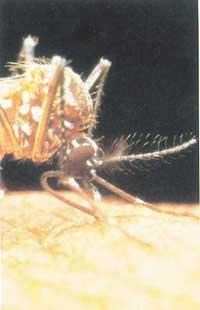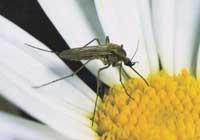Risks of insect bites
Bites from certain insects are known to cause allergies. However, the incidence of allergies is lower than expected, ranging from 0.3% to 3% of bites. On the contrary, insect allergies should not be taken jokingly for their low proportion. People with a tendency to allergy or severe reactions require a special protection system to cope with the summer “plague”.
Small enemies, but enemies
Not all insects are prickly and not everyone who pricks produces allergic reactions. Therefore it is necessary to know potentially dangerous insects.

Depending on the time the attack is carried out, insects can be distinguished that tend to puncture at sunset or in daylight. Light lovers include bees and bumblebees. They use the punch as protection: they are punctured when the hive is in danger and become aggressive at that time. Among the insects that puncture at night is the wasp and the curvature. The wasp lives on the floor, walls or grass and can die by passing by. It is very sweet, like substances that contain sugar and is therefore attracted by food or legends.
In addition, there are insects that bleed. Mosquitoes are the best known. Fluid flows from saliva butters, but they do not transmit allergenic substances and in most cases only produce a reaction around the bite.
The punch apparatus of insects begins in the abdomen. Both to attack and to protect themselves use the punch located at the end of the poison sac. This sack contracts and with the punch passes the poison to the enemy's tissues. We know that not all insects have the same puncture ability. Although bees die after the puyazo, wasps are able to hit long before they die.
The main allergens in the poison are well known. Bee venom, such as phospholipase A 2, hyaluronidase, the high molecular weight substance that contains the activity of acid phosphatase and melitin. For rat-prone insects, the composition of the poison is different: phospholipase, hyaluronidase and protein called Antigen 5.
Body Responses
Insect bites usually cause pain, swelling, and erythema around the punch. Normally these reactions disappear a few hours after the fist. However, there are reactions that can be more dangerous and persistent.
Expanded reactions from the site are reactions that spread not only around the punch stroke, but also through the body. They develop two days after the puyazo and take seven days to disappear. Although the cause of these reactions is unknown, antibodies in the E Ig group are considered to have a direct influence. As for cures, acetylsalicylic acid (650 mg oral and every 4 hours) and antihistamines (50 mg oral diphenhydramine every 6 hours) can be used. However, if inflammations and concerns continue to spread, prednisone, 40 mg oral, and 2 or 3 times a day may also be taken.

These reactions tend to be repeated. At most, only 5% of these cases develop anaphylaxis. These reactions are not tested on the skin, as they cannot be treated with immunotherapy.
Exposure to numerous punch strokes can cause toxic reactions. E Ig antibodies explain the same symptoms as anaphylaxis.
Numerous data have been published on abnormal reactions due to insect biting. These include vasculitis, nephrosis, neuritis, encephalitis and sera disease. Symptoms usually appear in days or weeks after puyada and their disappearance takes a long time to occur.
Anaphylaxis and its treatment
In any case, the most violent and dangerous reaction is anaphylaxis. Anaphylaxis is defined as the formation of a state of hypersensitivity in a second stage by a substance that, when first introduced into the body, caused a null reaction or poor response, and may also be due to the sting of insects. The most common symptoms are diffuse hives, redness, and angiodedema that appear on the skin and dermis. In addition, life-threatening reactions may occur, such as respiratory edema, circulatory collapse with hypotension and shock, and bronchospasm. These symptoms appear 10 to 20 minutes after the puncture.

At the moment, these reactions do not have much data. What we know is that 50% or 60% of patients with untreated previous anaphylaxis and positive skin tests are at risk of developing anaphylaxis again. It is believed that there is no relationship between the severity of the reaction and the serum level of E Ig, either with positive skin tests or with poison concentration.
Adults are at increased risk of anaphylaxis reactions being done again. Children who have had skin or dermal symptoms will hardly suffer these symptoms after a new punch and to a lesser extent if they have them. In any case, those who have never developed the symptoms of anaphylaxis are those who have a higher risk of redevelopment.
Allergic skin tests are the most effective ways to diagnose anaphylaxis. Samples of purified and freeze-dried poison are used for this purpose. The reaction with a dose between 0.1 and 1 micrograms/milliliter highlights the presence or not of a specific antibody E Ig against poison.
The usual anaphylaxis treatment will be used against the symptoms caused by the punch impact of insects. Subcutaneous adrenaline will be placed as acute as possible with a dose of 0.2 - 0.5 ml (dilution 1:1000) and if necessary will be repeated in half an hour. Antihistamines such as diphenhydramine can also be used, which reduce hives and growth. Other measures such as intravenous serum, oxygen, or bronchodilators may be taken depending on the symptoms. Symptoms will disappear in 15 or 30 minutes and if not, steroids will be used.

In any case, the best treatment is for people who have shown anaphylaxis to take prophylactic measures. The removal of insects, the availability of suitable drugs and the suitability of venomous immunotherapy is essential for them.
Venomous immunotherapy extends from the puncture of small doses of poison to the expected maintenance dose. Basically, this helps create anti-poison G Ig antibodies, decreasing the level of E Ig antibodies. Treatment should be followed for 3 or 5 years and until the skin test is negative. Only 2% of immunotherapist patients will suffer the symptoms of anaphylaxis again.





